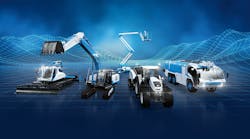Q&A: TTControl Sees Strong Development Synergies as Part of Autonomous Operation Cluster
TTControl – part of HYDAC Group and TTTech Group – recently formed a collaboration with several OEMs in the heavy equipment industry to advance development of autonomous systems. The new Autonomous Operation Cluster (AOC) will see TTControl working together with equipment manufacturers Ammann, Palfinger, Prinoth, and Rosenbauer to develop the necessary technologies for enabling autonomous machine functions.
The companies plan to jointly develop the technologies to help advance use of automation in construction equipment as well as heavy-duty on-road vehicles. Doing so will help to increase safety and productivity in these applications.
READ MORE: New Autonomous Operation Cluster Advancing Autonomy in Off-Highway Equipment
In this Q&A with Power & Motion, Leandro Antonio Zaza, Senior Technical Sales Manager & AOC Manager at TTControl, provides his insights into why the AOC was established and what technological advancements are hoped to be achieved.
Editor’s note: Questions and responses have been edited for clarity.
Power & Motion (P&M): How did the development of the AOC come about?
Leandro Antonio Zaza (LAZ): It was in September 2020, when one of the current AOC partners approached us to develop a platform for autonomous functions. While brainstorming on this topic, the idea of joining [the] forces of several partners with expertise from different industries came up for the first time.The reasons why we at TTControl founded the AOC are threefold:
As experts for functional safety of off-highway machinery, we at TTControl felt a strong push from the market for assistance functions to increase operator efficiency while ensuring appropriate safety.
At the same time, we see strong development synergies across industries: common technology building blocks can support the same function in different use cases. For example, an object detection function is a feature that is just as necessary for snow groomers as it is for fire fighting trucks, cranes or asphalt compactors. The core building block for implementing these functions can be used across different machines and industries.
By ramping up the overall production volume, we are securing access to the most important semiconductor suppliers. The competition for microchips in the world market gives an advantage to high volume manufacturers such as carmakers. By working together in the AOC, we aim to overcome this imbalance.
P&M: What is the benefit of several OEMs and a component supplier working together on such a collaboration?
LAZ: As partners in the AOC we pool our expertise. Each partner contributes their industry expertise, which we share for cross-market fertilization. TTControl is an expert on functional safety and will contribute to the core technological building blocks. We are working across off-highway markets on hardware and software platforms that enable vehicle manufacturers to develop highly reliable electronic control systems.
The common goal of the AOC is to accelerate the development of leading technologies, share know-how as well as investments.
P&M: What will TTControl be providing to this collaboration, and how will its involvement benefit the development goals of the AOC?
LAZ: For some time now, TTControl has had a dedicated team for development of emerging technologies in place. Our colleagues specialize in some of the key technologies that enable sophisticated automation functions: computer vision- and artificial intelligence-based technologies will enable precise detection of objects and help gather information from the surrounding environment. We are used to working in international cross-industry teams and have a well-proven DevOps IT tool chain for collaboration projects in place.
As part of TTTech Group, we have access to advanced technologies from the automotive market and also have contacts with key electronic suppliers in the autonomous field. TTTech Group also gives us access to a large pool of development know-how and resources within the group.
P&M: Why were robust hardware platforms, modular software components and customized application functions chosen as the three development areas in which the AOC will focus? How will development of these areas aid with implementation of autonomy?
LAZ: We have found that for the functions currently available, industrial PCs are deployed for small production. Those are generally far from meeting the off-highway market requirements for robustness and quality standards for high-volume series production.
The AOC aims to drive the development of a series-oriented and robust embedded hardware solution that meets the technical and environmental challenges of the off-highway application.
The modular approach to software architectures allows us to meet emerging market trends such as paid services activated on-demand on the machines and the variety of possible autonomous functions in different application scenarios. This allows us to meet the dynamic needs of end-users while maintaining consistency and the same quality and safety standard.
The development of customer-specific application functions is mainly done by our OEM partners in the AOC. The interface layer to the end-user and how and which functions are activated, and what impact they will have on the machine, is the core know-how of our OEM partners.
P&M: Is it just autonomous systems/functions that are being developed, or will fully autonomous vehicle development also be a part of the collaboration?
LAZ: The first steps focus on the development of autonomous functions. The long-term vision is to further increase the level of autonomy of vehicles. The deployment of a fully autonomous vehicle also dependents on other factors, not just technology but norms, safety standards and market acceptance, among others.



